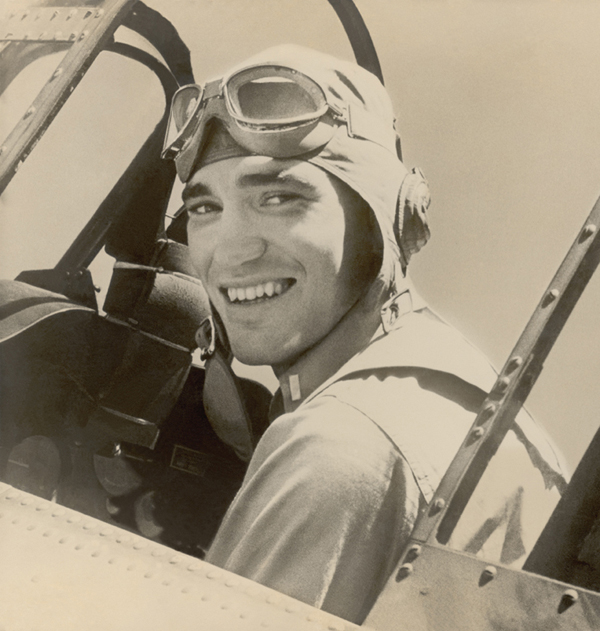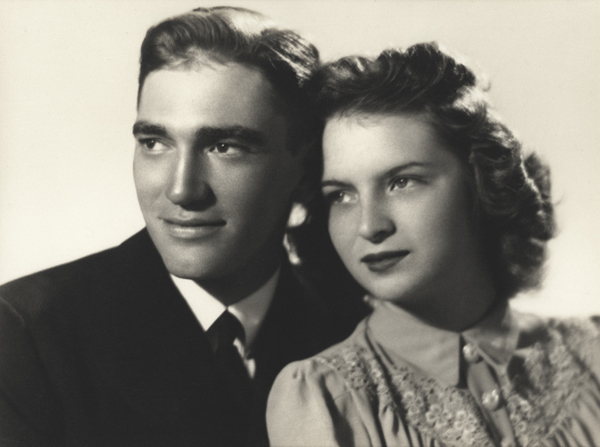
LTJG Norman Taylor Dowty
The photographs and citations below appear courtesy of Amy Dowty Lore, the daughter of Norman Dowty.

LTJG Norman Dowty in the cockpit of a TBF-1C in 1942 |
________________________
Norman Taylor Dowty was born December 14, 1919, in New Orleans and grew up in Alexandria , Louisiana . Attending college at what is now Northwestern State University, he was suspended for riding in a car with a female student and spent a year riding the rails of depression America with his fellow hoboes. He returned to school and in June, 1941, joined the Navy as an air midshipman. He married Rivers Rhodes in August, 1942. The two spent a crazy time attempting to stay together while in the wartime Navy. There were six assignments on the Atlantic, Great Lakes, and Pacific coasts in less than a year. |

Rivers and Norman Dowty in October, 1942 while Norman was in carrier training at the Great Lakes Naval Station |
Beginning in August, 1943, his squadron, VC-6, was ordered to combat duty in the Atlantic, providing an air arm for escort carriers Croatan, Core, and Block Island. On March 16, 1944, LTJGs C.A. Wooddell and his fighter escort Paul Sorenson were launched from Block Island to search for enemy submarines. They sighted U-801 about 10 miles away. Sorenson strafed the boat and Wooddell dropped two depth bombs which exploded 50 yards to starboard. The boat submerged and Wooddell dropped a MK-24 acoustic homing torpedo which missed. That night, Avengers piloted by LTJGs J. W. Steere, Powell, Conkling, and Elefter dropped sonobuoys which picked up submarine sounds and another MK-24 torpedo was dropped without result. Just after midnight, radio transmissions from U-801 were detected by Block Island's HFDF gear and the destroyer Corry and an Avenger piloted by Dowty were sent to investigate. Dowty and his longtime radioman, ARM1/c Edgar Burton, dropped sonobuoys throughout the night, often flying at 100 feet above the waves. At 0427, they spotted the feather of a periscope and dropped a MK-24 torpedo just as it submerged. The weapon exploded, violently shaking the boat and causing a crack 15-20 cms. long and 2 mm. wide in the pressure hull in the Diesel compartment. Dowty was unsure if they had damaged the boat, but at dawn they saw an oil slick originating where they had dropped the MK-24. Forced to return to the carrier due to lack of fuel, a jubilant Dowty radioed in the news. The destroyers Corry and Bronstein gained sonar contact and conducted eight depth charge attacks. At 1118 U-801 surfaced and was taken under fire by the destroyers. The crew abandoned ship and the boat sank at 1124. 47 crewmen were rescued. Just two days later on the morning of March 19, south-west of the Cape Verde Islands, LTJG Dowty and his fighter escort LTJG William Cole sighted U-1059 fully surfaced about 10 miles away. Cole pushed over and conducted a strafing attack from the boat's port quarter. According to the testimony of the survivors, U-1059's gunners fired heavily on the attacking planes. Dowty followed Cole's attack dropping two Mark 47 depth bombs which exploded on either side of the conning tower. The explosions raised the submarine high in the water and it sank stern first within 20 seconds. Fifteen survivors were seen in the water, eight of whom were rescued. Immediately after delivering the depth bomb attack, the TBF was seen to circle wheels down, then suddenly dip one wing and fall into the water. LTJG Norman Dowty and his radioman ARM1/c Edgar Burton were lost. Ensign Mark E. Fitzgerald, who was flying in the TBF as an observer, survived the crash. Norman Dowty was awarded the Navy Cross for his "extraordinary heroism" and "brilliant airmanship" against U-1059. Fellow crewman Franklin Woodward, VC-6 historian, submitted this tribute : "LTJG Norman Dowty's death was a heavy blow to the squadron, for he was one of its best liked and oldest members. This officer and his radioman, ARM1/c Edgar Burton, had both done by far the outstanding work on the cruise, and it seemed ironically tragic that they both should die before realizing that they had been responsible for the squadron's most outstanding success in battle." |
________________________
The award citation below is for action against U-801 on March 17, 1944 At the time the award was submitted it was not known that Dowty's attack with a MK-24 torpedo had damaged U-801, causing the boat to trail an oil slick which led to its destruction by depth charges from USS Corry and Bronstein later that day. Had this been known, the award would likely have been upgraded to a Distinguished Flying Cross. |
THE SECRETARY OF THE NAVY |
||
WASHINGTON |
||
| The President of the United States takes pride in presenting the AIR MEDAL posthumously to | ||
LIEUTENANT, JUNIOR GRADE, NORMAN TAYLOR DOWTY |
||
UNITED STATES NAVAL RESERVE |
||
| for service as set forth in the following | ||
| CITATION: | ||
| "For meritorious achievement while participating in aerial flight as Pilot of a United States Navy Torpedo Bomber in action against an enemy submarine in the Atlantic Ocean March 17, 1944. Launched from his carrier during the night to investigate a suspected re-contact with a hostile ship which had previously evaded planes of his task group, Lieutenant, Junior Grade, Dowty successfully obtained radar contact and, although the enemy vessel submerged before he could deliver an attack, skillfully and with relentless determination tracked the submarine for two hours, attacking immediately when it attempted to resurface. Forced by lack of fuel to return to his carrier at dawn, he provided vital, accurate information regarding the enemy's position, thereby enabling surface ships to contact and destroy the hostile vessel. Lieutenant, Junior Grade, Dowty's expert airmanship and tenacious devotion to duty under difficult conditions were in keeping with the highest traditions of the United States Naval Service." " | ||
| For the President, | ||
 |
||
| Acting Secretary of the Navy. | ||
The citation below is for action against U-1059 on March 19, 1944 |
THE SECRETARY OF THE NAVY |
||
WASHINGTON |
||
| The President of the United States takes pride in presenting the NAVY CROSS posthumously to | ||
LIEUTENANT, JUNIOR GRADE, NORMAN TAYLOR DOWTY |
||
UNITED STATES NAVAL RESERVE |
||
| for service as set forth in the following | ||
| CITATION: | ||
| "For extraordinary heroism as Pilot of a Torpedo Bomber in action against an enemy submarine in the Atlantic Ocean on March 19, 1944. Sighting the hostile ship while participating with an accompanying fighter plane in a search flight, Lieutenant, Junior Grade, Dowty unhesitatingly went into action and, skillfully maneuvering his craft into position for a powerful strike, pressed home his daring, aggressive attacks at perilously low altitude in the face of intense, persistent antiaircraft fire and accurately released depth bombs which exploded on the deck of the submarine and completely destroyed the enemy vessel. Lieutenant, Junior Grade, Dowty's brilliant airmanship, indomitable fighting spirit and valiant devotion to duty throughout this extremely hazardous engagement reflect great credit upon himself and the United States Naval Service." | ||
| For the President, | ||
 |
||
| Acting Secretary of the Navy. | ||
A gold star in lieu of a second Air Medal was later awarded to Norman Dowty for his material contribution to curtailment of hostile submarine activity during 1943 and 1944. |
Click the icons to view the associated records |
||
| Return to the U-801 page | ||
| Return to the U-1059 page | ||